This post is part of our Behind the Bite series, deep dives into the dishes that we can’t stop thinking about.
Place it on your toast with a drizzle of olive oil and you have breakfast.
Add it to eggs and potatoes for a memorable lunch. On its own with a glass of sherry? The most perfect aperitif.
No one would plan a wedding without it. Christmas would lose its magic if there wasn’t at least one big plate of it on the dinner table.
Its power is such that it can turn many vegetarians into carnivores for a few unforgettable seconds.
What is this legendary bite? Spanish cured ham, of course!
In Spain, nothing is more loved than jamón, and we’ve got the numbers to prove it. The country produces over 40 million legs of ham each year, and it’s estimated that the average Spaniard eats almost 5 kilograms of the tasty stuff every year.
Click to expand or embed this image on your site
Legend vs. history
So how did this iconic food come to be?
Legend has it that jamón was born after a clumsy pig fell in a particularly salty stream and drowned. Not wanting to waste the meat, the villagers roasted it for dinner and discovered that the hind leg tasted especially delicious.
If history books seem to disagree about who really did first start curing pig legs, most are clear that ham was already considered a delicacy in Roman times. In those days, it was exported throughout the Empire, and reserved only for the elite.
After the year 711, when the Islamic Moors first started conquering Spain, jamón became a Christian symbol and a tool of resistance. In the late 15th century, as Muslims and Jews were either expelled from Spain, forced to convert to Christianity, or burned at the stake, eating pork (something forbidden in both the Quran and the Torah) became a matter of life and death. Hanging a jamón by your window would show nosy inspectors of the Holy Inquisition that you had let go of your old beliefs, and thus could literally save your skin.
This legacy has carried over to the present day, with ham remaining a staple of everyday life in Spain.

The best ham in the world
When it comes to jamón, it’s important to bear in mind that from one hind leg to the next, quality can vary a great deal. Not every ham gets to be the best ham in the world.
Serrano ham, for example, is nearly always the result of intensive farming.
“It’s a more basic ham, from a common pig. Most people buy it for everyday breakfast,” explains jamón expert Gema Alastuey.
In Corta y Cata, her bright, eye-catching stall in the Mercado de la Encarnación, Gema specializes in cured products of the finest quality. Moving on from the serrano ham, she shows us her absolute best jamón: a jamón ibérico de bellota, the crème de la crème of jamón. This culinary masterpiece makes anything prosciutto or serrano pale in comparison.
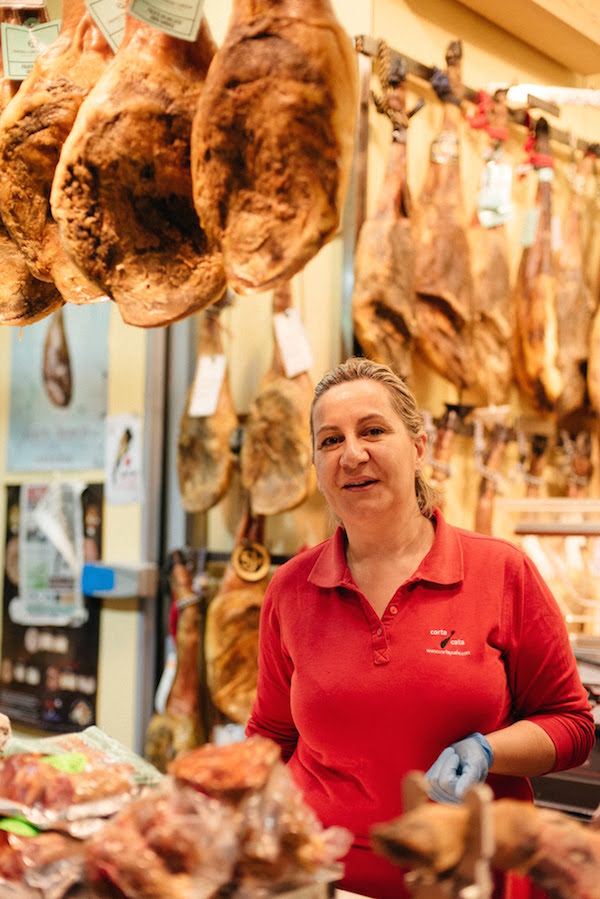
The “recipe” for the world’s best ham
It may sound straightforward: First, take a purebred Iberian pig. Let it roam freely on a natural diet of grass, and acorns. Sacrifice it in stress-free conditions. Bury its hind leg in Atlantic sea salt and hang to dry. When ready to eat, keep at room temperature, slice by hand, and serve immediately.
The result: the most exquisite ham you’ve ever tasted. A melt-in-your-mouth square of intense, nutty aromas and salted goodness.
If we tricked you into believing that making jamón ibérico de bellota is an easy process, a simple look at the price tag will convince you otherwise. With prices often reaching way above €600 a piece, it’s clear that much time, care and expertise goes into making this particular kind of jamón taste as outstanding as it does.
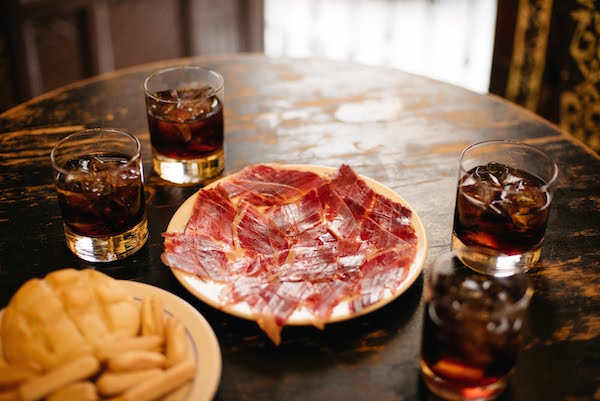
There are actually three main factors that determine the quality and price of a jamón ibérico:
1. The pig’s heritage
Jamón ibérico comes from Iberian pigs: a dark-skinned, black-hoofed breed that is native to Spain and Portugal. On top of their superb flavor, they also have a unique genetic structure that enables them to store fat in muscle tissue. The result is a soft and silky texture, with fat marbled all throughout the meat.
To receive its ibérico status, a pig must be at least 50% Iberian. The better its pedigree, the higher you should expect to pay.
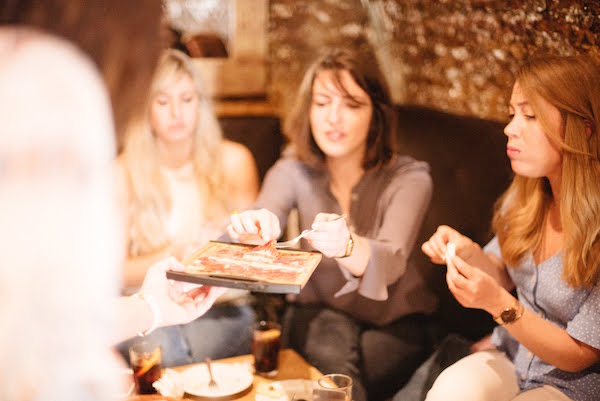
2. The pig’s diet and lifestyle
If the label on your ham indicates that the jamón is “de bellota,” you’re in for something special.
These two little words tell us that not only was the animal raised free-range in the dehesa (ancient oak meadows found in Western Spain), but that it dined on a natural diet of grass, roots, insects, and most importantly, acorns (bellotas).
In the winter months, pigs roaming the dehesa will eat around seven kilograms of acorns a day. Those precious nuts are what gives the meat its intense aroma. Being rich in oleic acid, they make the unsaturated fat healthy and flavorful. Every week, new studies are published to prove that acorn-fed jamón really does keep the doctor away!
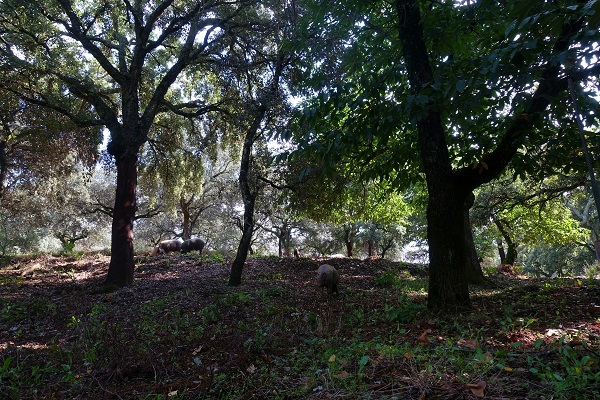
3. The curing process
Not to be underestimated, the curing process is evidence that good things come to those who wait… at least two years! In fact, most Iberian hams are dry-cured for an average of 3-4 years, and some have even been known to exceed 6 years of curing time.
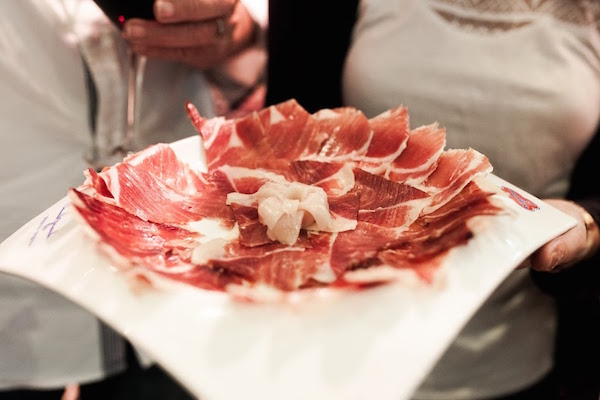
How to choose your ham
As a fervent defender of her region, Gema assures us that the best jamón hails from the Huelva area in southwestern Spain. According to the experts, Huelva boasts an ideal climate, with a level of humidity that is ideal for curing.
More importantly, the area is known to follow only natural methods of dry-curing. Farmers from other regions often resort to fans to speed up the process, resulting in the ham losing its aromas. In Huelva, Gema tells us, “Ham masters are paid to open and close windows depending on the wind. Nothing more. This undeniably takes longer, but the jamón ages better and retains all the intensity of its flavors.”
With so much to look out for, picking a good jamón might seem like an impossible task. Luckily, in 2014, Spain simplified its labeling system to offer more transparency to consumers. Ibérico hams are now divided into 4 distinct categories, easily identified thanks to the colored tag that they must wear near their hoof.
- White tag: From crossbred pigs that were fed grains and raised indoors.
- Green tag: From free-range crossbred pigs that were mainly fed grains.
- Red tag: From free-range crossbred pigs that fed on acorns and natural resources from the dehesa.
- Black tag: The highest quality of jamón, from free-range 100% ibérico breed pigs that fed on acorns and natural resources from the dehesa.
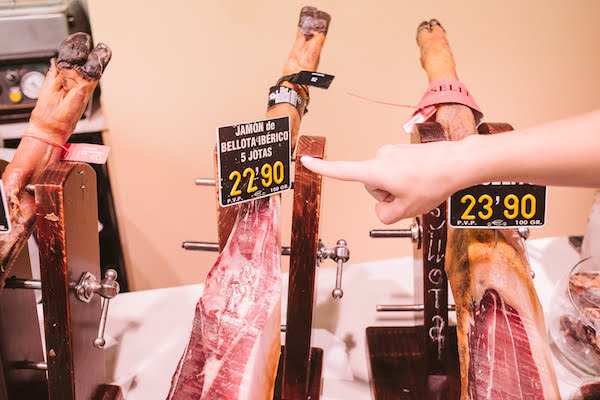
So there you have it. If you listen to Gema’s advice, “the best ham in the world is jamón ibérico de bellota 100%, from Huelva, sliced by hand with jamor.”
Jamor? “When we work with jamón, we do it with much love. Mucho amor. We call it jamor.”
Where to try jamón in Seville
If we’ve convinced you to try jamón ibérico in Seville, be sure to visit Gema at Corta y Cata for a tasting you won’t soon forget.
Fancy sitting down? Las Teresas, in the neighborhood of Santa Cruz, offers jamón of the highest quality in a timeless setting: a picturesque tapas bar that opened in 1870!
For a more fancy experience, head to Cinco Jotas. The best brand of jamón, according to Gema and many more, has opened its own restaurant in Seville. All of their pork dishes come from 100% Iberian acorn-fed pigs. Perfect for if after sampling the ham, you want to find out what the rest of the black-hoofed pig tastes like. (Spoiler: it’s delicious).
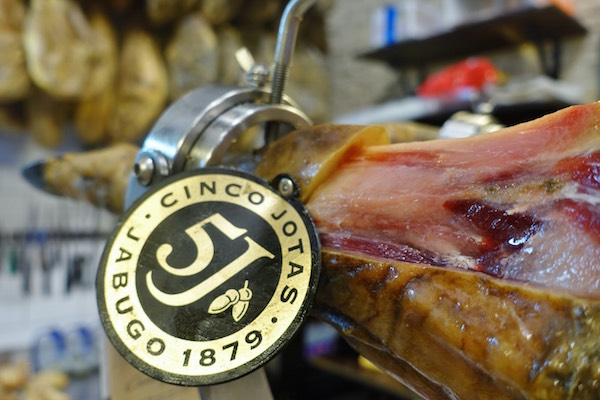
A heavenly combination
Even though most Spaniards wouldn’t dream of having jamón ibérico de bellota served any way other than on its own, there’s still some novelty in the ham world today.
In an attempt to reduce food waste, chefs around the country have been coming up with new ways to use leftover parts from a leg of ham, such as bones and fat. Iberian ham oils, for example, are becoming popular in haute cuisine.
Famous Catalan chef Paco Pérez believes he has the winning combination. In Miramar, his Michelin 2-star restaurant, he serves his breakfast toast with “crema de chocolate ibérica:” a heavenly spread made of chocolate, hazelnuts—and jamón ibérico!
The recipe may surprise at first, but what isn’t to love about bringing two of the world’s best things together?
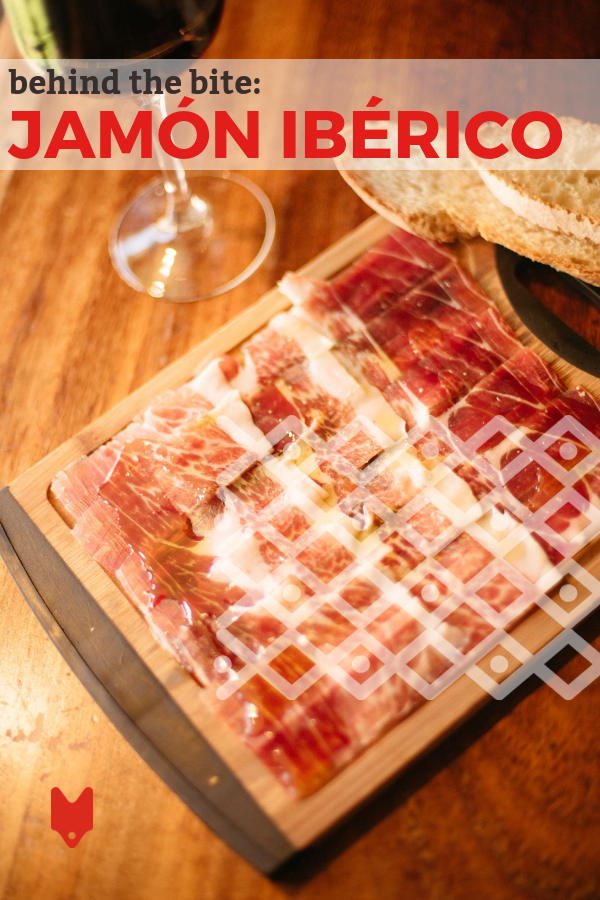







Where in the USA CAN I GET OR BUY Jamon Iberico de bellota .
Hi Ramón, La Tienda (https://www.tienda.com/jamon/index.html) is a great option for ordering jamón in the US. Que aproveche!
Very good iberian ham explanations. 100% iberico bellota hams are always the best option to choose!
Thanks for reading, Mar!